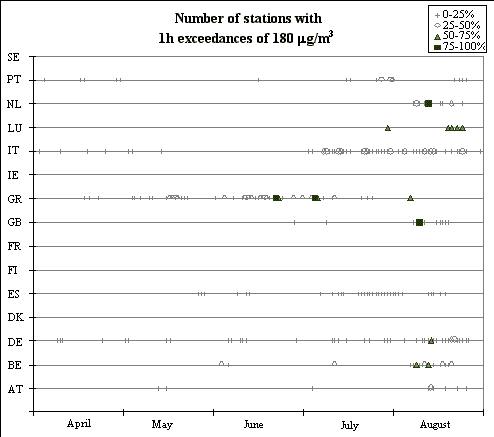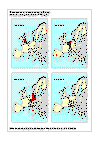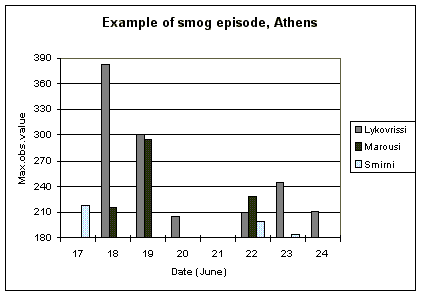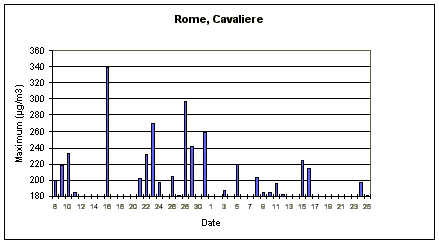5. MAIN OZONE EPISODES
Ozone formation and destruction is dependent on emissions,
concentrations and ratios of precursors (mainly VOC, CO and NOX), and on the
amount and intensity of sunlight. Important in this respect is the role of nitrogen oxide
emissions. In urban areas, the ozone concentrations may be lower than the rural
('background') concentrations due to chemical scavenging by local nitrogen oxide emissions
(see for example Figure 3, which shows that the occurrences of exceedances are in general
highest at rural stations).
Episodes, periods with elevated ozone levels, will mainly occur during
periods of warm sunny weather. In the Mediterranean countries, having prolonged spells of
hot and sunny weather during the summer, ozone can quickly be formed and high levels can
occur on many days and in the vicinity of urban centres. In northern Europe the build up
of ozone is slower due to the more moderate weather conditions. Here, highest levels will
generally be found downwind of cities. Figure 6 presents a graphical representation of the
percentage of stations in every Member State that reported exceedances of the threshold
value for population information (180 µg/m3 for hourly values) during the 1997
summer season.

Figure 6: Qualitative overview of exceedances of the 180 µg/m3
population information threshold value (1h) during the period April - August 1997. The
symbols represent the percentage of stations which observed at least one exceedance of the
threshold for the information of the public during a particular day. Note: data from
France is missing.
From Figure 6 it is clear that the number of episodes covering extended
areas of the European territory was limited during April-July 1997. As already mentioned
in Section 3, weather conditions in western and northern Europe were often unfavourable
for the build-up of ozone. On many days cool and relatively clean Atlantic air masses
prevailed in northern and western European countries.
More frequent exceedances were observed in August. The most widespread
northern European episode this summer occurred between 10 and 14 August. Map 4 presents an
overview of the sites which observed an exceedance on 10, 13 14 and 15 August 19971. In the text box, the conditions leading to this episode are
described in more detail. In contrast, in southern Europe frequent exceedances are
observed throughout the reporting period.
The episode of 10-14 August 19972
During the first days of August, a high pressure cell formed over
Scotland- southern Scandinavia. This resulted in a NE circulation over a large part of
northern and western Europe with sunny skies and high temperatures. The air mass present
was relatively clean. On 10 August, the high pressure cell had slightly shifted position
to the east and in combination with a depression west of Ireland the circulation became
SE, first in the United Kingdom, transporting more polluted air from the continent to the
west. Exceedances were observed in the United Kingdom and Belgium. The synoptical
situation remained more or less stable till 12 August with exceedances concentrated in the
United Kingdom, Belgium, Netherlands and the western part of Germany. A cold front, behind
it relatively clean Atlantic air, moved in from the west on 13 August ending the episode
in the United Kingdom. Preceding the cold front, under sunny skies and tropical
temperatures, exceedances were observed on a large scale in Benelux and Germany. On 14
August, the cold front was positioned over the central part of Germany ending the episode
in Benelux and the western part of Germany. On 15 August, the relatively clean Atlantic
air had reached the eastern part of Germany and this ended the episode. |

Map 4: Example of a smog episode: stations which reported an hourly ozone
concentration in excess of 180 µg/m3, 8-14 August 1997 (all station types).
Note that data from France is missing.
Figure 7 presents the maximum hourly ozone values recorded in the Athens conurbation
(Greece) as an example of a local ozone episode in the Mediterranean region. The threshold
for warning of the public (1h >360 µg/m3) was exceeded in Athens. Note that
not all stations presented reported exceedances on every day during this period. More
information on the specific conditions leading to these particular episodes is not yet
available to the authors of this report.

Figure 7: Example of a local ozone episode, Athens 17-24 June 1997. Maximum observed
1h values (µg/m3) on stations in the Athens conurbation which observed an
exceedance of at least 180 µg/m3 (1h).
Figure 8 presents the maximum hourly ozone values recorded at the Cavaliere station in
Rome (Italy) during exceedances of the population information threshold in the period
July-August. It is an example of a station in the Mediterranean region at which frequent
exceedances are observed throughout the summer period.

Figure 8: Example of a station with frequent exceedances throughout the summer
period, Cavaliere, Rome (Italy), July-August 1997. Maximum observed 1h values (µg/m3)
observed during an exceedance of at least 180 µg/m3 (1h).
1 Note that the exceedances
during this episode on 11 and 12 August are not presented. The situation on those two days
was comparable with 10 August.
2 Although no data for France
was received, it is to be expected that exceedances also occurred in France during this
episode.





Document Actions
Share with others